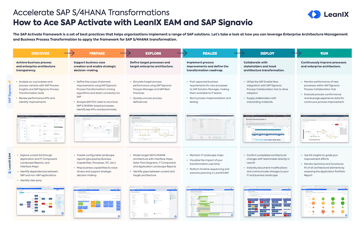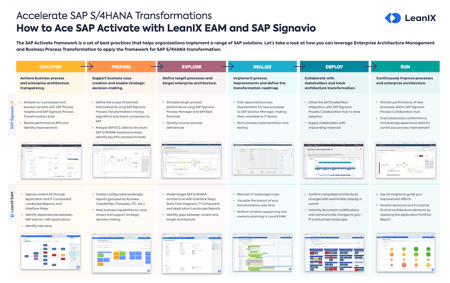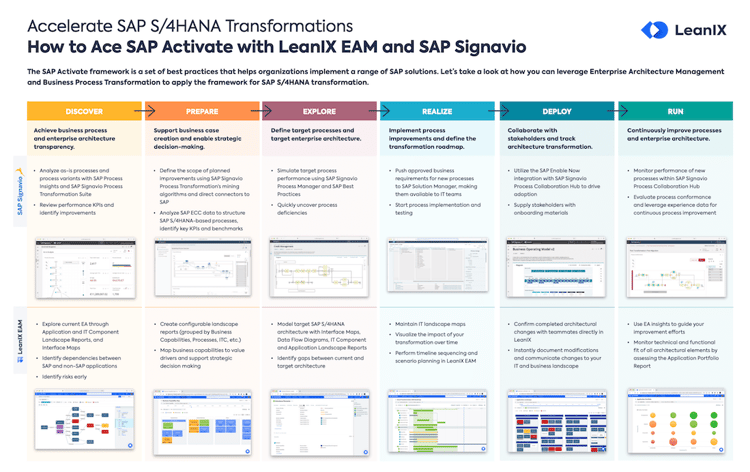Discover As-Is architecture with LeanIX EAM
As-Is architecture transparency is required during the Discover phase to identify dependencies between IT and processes, as well as uncover risks. An enterprise architecture solution such as LeanIX EAM perfectly aligns with SAP to allow companies to execute S/4HANA transformations. It also activates other continuous transformation initiatives and produces a holistic overview of the as-is and target IT landscape. LeanIX EAM is the only enterprise architecture solution to be part of the SAP Endorsed App catalog.
The LeanIX EAM accelerates SAP S/4HANA transformation, by revealing the complexity, risks, and strategic business value associated with change initiatives. During this activity, SAP customers use key business data to coordinate migration plans, standardize processes, manage integrations, and rationalize applications.
The result of this process is to create a scalable, shared inventory that streamlines the process of exploring the as-is architecture. Detailed SAP mapping during the Discovery phase provides clear documentation of the current process state and uncovers areas of process improvement that are added to SAP RICEFW. SAP architecture discovery using the LeanIX EAM tool lets users:
- Explore the as-is architecture and classify business capabilities.
- Model and compare migration scenarios.
- Identify dependencies between applications in the IT landscape.
- Optimize process mapping with clear links to available technical support.
The result is to achieve process and architecture transparency. Combining BPI with the LeanIX EAM makes this part of the process more concise and in-depth. By adopting both BPI and EAM tools, businesses can leverage a holistic process landscape that will form the pillars of a successful transformation.
Create a high-level project timeline
By completing the previous steps, project managers are now capable of creating a high-level project timeline and picking the right deployment option. The objective of this activity is to create a company-specific innovation strategy, and derive a high-level timeline and roadmap from here.
SAP Best Practice instructs teams to start with the identification of strategic business and IT objectives – including pain areas. Each of these objectives can be clustered into benefit areas. For each benefit area, solutions such as SAP S/4HANA (or other solutions or platform components) need to be identified, prioritized, and benchmarked.
The S/4HANA timeline that is produced will document the main transition steps from the as-is architecture to the target architecture. Establishing a dedicated SAP Center of Excellence can greatly benefit this step.
The direction of the S/4HANA project and roadmap will then depend on which transition strategy is used. After establishing the deployment option (Cloud or On-Premise), either a Brownfield, Greenfield, or hybrid migration approach will be implemented.
A Greenfield approach simply refers to a complete reengineering of an organization’s SAP processes and workflows – essentially starting from a blank slate. The Brownfield approach acts more like an upgrade; it involves migrating existing workflows and systems over to the newest version of SAP S/4HANA.
The result of this activity is a roadmap that will determine the next steps in the SAP project timeline
Prepare value case
The final activity in the Discover phase is to prepare the SAP value case for the S/4HANA transformation. The value case will outline the implementation scope, project timelines, and a targeted solution model.
All documents should be uploaded and stored in a central location (such as the SAP Solutions Manager) so they can be easily accessible. The following should be present in the value case:
- Key findings from the previous steps: Key data and information gathered during the trial phase and business process activities should be presented.
- Identify the impact on architecture: Present all the ways in which the transformation will impact the architecture – including benefits and associated risks.
- Consider parallel initiatives and projects: Offer parallel initiatives in the value case to provide stakeholders with alternative roadmaps and segments.
- Establish SAP CoE if it doesn’t exist yet: An SAP Center of Excellence accelerator supports the overall strategy and highlights the importance of governance.
During this task, implementation teams will develop the building blocks required to reach the target architecture in line with defined KPIs. They will compose a consolidated SAP roadmap of the building blocks to begin implementing the solution. During this step, both value and cost drivers will be determined.
Once this is complete a documented implementation roadmap will be available, ready to execute the most efficient and effective SAP strategy for transformation.
Conclusion
The SAP Discover phase is designed for businesses to uncover the value of the planned implementation project, and to build a S/4HANA business case. It’s where customers become familiar with the solution, and begin to map their business processes and technology landscape to plan the S/4HANA transformation.
Once this step is completed, businesses are well-equipped to move into the next phase of the SAP Activate methodology – the Prepare phase.
To accelerate the S/4HANA transformation process during the Discover phase, SAP provides valuable internal tools such as SAP Signavio and SAP Discovery Center. They also endorse third-party apps such as the LeanIX EAM to work in tandem as an enterprise architecture solution for SAP.



/EN-S4Hana-Roadmap-Poster_Resource_Page_Thumbnail.png?width=400&height=280&name=EN-S4Hana-Roadmap-Poster_Resource_Page_Thumbnail.png)
/EN/Reports/EN-LX-SAPS4HANA-Survey-Resource-Page-Thumbnail.png?width=260&height=171&name=EN-LX-SAPS4HANA-Survey-Resource-Page-Thumbnail.png)
/EN/White-Paper/EN-SAP-Getting-it-Right-WP-Page-Thumbnail.png?width=260&height=171&name=EN-SAP-Getting-it-Right-WP-Page-Thumbnail.png)
/EN/Video/Webinar-Thumbnail-360x250@2x-2.png?width=260&height=171&name=Webinar-Thumbnail-360x250@2x-2.png)
/EN-WP-SAP-S4Hana-Migration-Resource_Page_Thumbnail.png?width=260&height=171&name=EN-WP-SAP-S4Hana-Migration-Resource_Page_Thumbnail.png)

